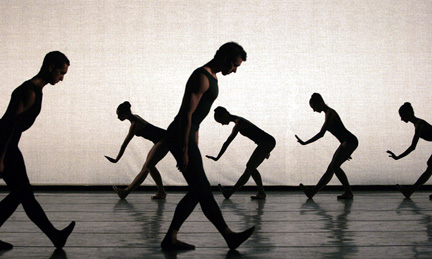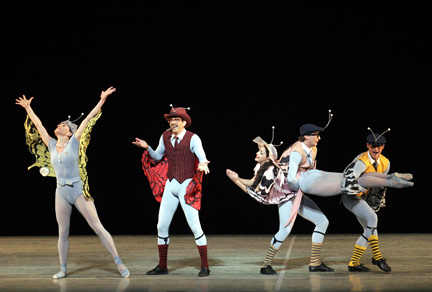"Raymonda
Variations,” “Continuum,” and “The Concert (or,
the Perils of Everybody).”
Pennsylvania Ballet
Merriam Theater
Philadelphia, Pennsylvania
April 29, 30, 2005
by
Dale Brauner
copyright
©2005 by Dale Brauner
The key marketing ploy in ballet these days is to convince the public that they are seeing something “new,” “exciting” and “NOT ballet.” That’s because ballet is considered “boring,” “old fashioned,” and “elitist” to some. Choreographers now don’t just make dances; they look to bring ballet into the 21st century. Despite all the posturing, much of the work looks like been-there-done-that by viewers with memories longer than three years.
The three choreographers providing works for the Pennsylvania Ballet’s fifth program of the season chose to look back to bring ballet forward. Their work comments on ballet lovingly, building on the art form’s heritage to advance our notions of technique and style.
George Balanchine’s “Raymonda Variations” opened the bill at the Merriam Theater and was followed by two company premieres—Christopher Wheeldon’s “Continuum” and “The Concert (Or, The Perils of Everybody)” by Jerome Robbins.
Balanchine loved the music of “Raymonda” by Alexander Glazounov and returned to it throughout his life. Balanchine, who danced in the Maryinsky Theater production choreographed by Marius Petipa while a student in St. Petersburg, set the full-length work on the Ballet Russe de Monte Carlo in 1946 with Alexandra Danilova. He also produced three ballets to portions of the score for the New York City Ballet: “Pas de Dix” (1955), “Raymonda Variations” (1961), and “Cortege Hongrois” (1973).
While “Pas de Dix” and “Cortege Hongois” use music mostly from Act III of the longer work, “Raymonda Variations” utilizes the score from Act I, the section in which we are introduced to the noble woman Raymonda and her court. Balanchine does not follow the full-length work, but he does capture its essence. In the work’s harmonious groupings of its pink-tulle wearing corps de ballet, we can smell the flowers presented to Raymonda at her castle.
The ballet is comprised of nine variations. The principal dancers each perform two while five members of the corps step forward to take one each. These variations are basically a lesson in classical technique. Everything is explored—pointe work, jumps and all manners of turns. But instead of just pouring forth, Balanchine uses Petipa’s outline as a starting point. For example, the first variation is one in which the demi-soloist hops on pointe. Petipa also has a variation with hops on pointe in "Raymonda," but Balanchine takes things further by having his dancer travel across the stage on one toe.
That variation was a winner for both casts I saw of the program as Jessica Gattinella (in the second cast on Friday) and Heidi Cruz (first cast on Saturday) handled the challenge with ease and charm. The other variations also were performed strongly, with Emily Waters and Tara Keating earning special honors for their work with the jumping variation.
The leading role suited newly named principal dancer Rioloma Lorenzo, with her generous proportions and long line, better than it did Arantxa Ochoa, whose nervous aura is an asset in “Agon” but can make her look brittle in classical works. Lorenzo performs the grand ballerina parts with authority, pairing an open engaged upper body with full positioning of her legs. She not only overcame the loss of her scheduled partner, the injured Zachary Hench, but also the loss of the melodic accompaniment when the first French Horn player couldn’t get through her solo. But Lorenzo graciously sailed through as if there were no problems. In her second solo (which should escalate to a thrilling conclusion of flying pas de chats), Lorenzo instead performed four perfectly executed double pirouettes.
James Ihde gamely stepped in for Hench (omitting his second solo) as the cavalier, but the part was more fully realized on a technical level by Ochoa’s partner, James Ady, who is riding a high after being promoted to principal last month.
 “Continuum”
is one of three ballets Wheeldon has choreographed to Gyorgy Ligeti’s
music for piano and probably the most accessible. Not surprisingly, he
made the work on the San Francisco Ballet in 2002 instead of the New York
City Ballet, where he holds the title Resident Choreographer. His work
for outside companies tends to be warmer than those for the New York troupe.
This was the second Wheeldon ballet performed by Pennsylvania Ballet,
which presented a world premiere of the English-born choreographer’s
“Swan Lake” last summer.
“Continuum”
is one of three ballets Wheeldon has choreographed to Gyorgy Ligeti’s
music for piano and probably the most accessible. Not surprisingly, he
made the work on the San Francisco Ballet in 2002 instead of the New York
City Ballet, where he holds the title Resident Choreographer. His work
for outside companies tends to be warmer than those for the New York troupe.
This was the second Wheeldon ballet performed by Pennsylvania Ballet,
which presented a world premiere of the English-born choreographer’s
“Swan Lake” last summer.
Wheeldon takes as his reference point Balanchine’s own modernist works such as “The Four Temperaments,” “Agon” and “Symphony in Three Movements.” “Continuum” is made up of a series of solos and duets performed by four couples dressed in variations on Balanchine’s favorite black leotards and pink or white tights, although here the dancers are in hunter green and white tights. Unlike some choreographers, Wheeldon takes on Balanchine while offering his own statement. He clearly is quoting the grand master’s “Episodes” when, in a quartet for four men, he has them twist themselves around each other while continuously holding hands. In the Balanchine, the section was made on a woman, a man and a female corps de ballet. The woman is either trapped or trying to figure her way through an elaborate puzzle. Wheeldon’s mass seems to be ever evolving, not moving through a maze but moving into something entirely different.
Wheeldon also often has the men turn their partner’s upside down, as Balanchine did in a section of “Episodes.” In “Continuum,” the woman are often stretched and contorted. The first cast of Ochoa, Lorenzo, Julie Diana and Martha Chamberlain was better at twisting themselves in knots than the second cast of Meredith Reffner, Tara Keating, Amy Aldridge and Valerie Amiss. But both Diana (in a part created on her) and Keating were touching in a poignant solo.
 Robbins
takes on all of our favorite ballet traditions in the hilarious “The
Concert.” No doubt his days at Ballet Theatre allowed him to gather
the material he would later use in this ballet in 1956. Robbins starts
his ballet off by examining the typical personalities at a typical concert.
There is a diva-esque Chopin-playing pianist, the quiet music lover, the
aggressive patron everybody else is afraid to confront, the drama queen
and a nagging wife with her beleaguered bore of a husband. Each character
is so clearly thought out, so perfectly delineated—it was one of
Robbins’ great gifts. One of his other great gifts was for comedy
and the ballet soon veers into nuttiness with humorous allusions to “Swan
Lake,” “Giselle” and “Les Sylphides.”
Robbins
takes on all of our favorite ballet traditions in the hilarious “The
Concert.” No doubt his days at Ballet Theatre allowed him to gather
the material he would later use in this ballet in 1956. Robbins starts
his ballet off by examining the typical personalities at a typical concert.
There is a diva-esque Chopin-playing pianist, the quiet music lover, the
aggressive patron everybody else is afraid to confront, the drama queen
and a nagging wife with her beleaguered bore of a husband. Each character
is so clearly thought out, so perfectly delineated—it was one of
Robbins’ great gifts. One of his other great gifts was for comedy
and the ballet soon veers into nuttiness with humorous allusions to “Swan
Lake,” “Giselle” and “Les Sylphides.”
Lorenzo took the lead (the drama queen with a penchant for elaborate hats) on Friday, and Ochoa led things on Saturday. Both are strong dance actresses who embraced the zaniness with both arms. They and the rest of the cast understood that Robbins was not scorning ballet with his lampoon. He was saying, “This is who were are and we’re not afraid to laugh at ourselves.” This program showed that ballet doesn’t have to be cooler, edgier or slicker. It just has to be beautiful, brainy and fun. And it is.
Photos:
First: Pennsylvania Ballet Dancers in the Company Premiere of Christopher
Wheeldon's "Continuum." Photo: Paul Kolnik
Second: Christine Cox, David Krensing, Riolama Lorenzo, Alexei Charov
and Philip Colucci in the Company Premiere of Jerome Robbin's "The
Concert". Photo: Paul Kolnik.
Volume 3,
No. 18
May 9, 2005
copyright
©2005
Dale Brauner
www.danceviewtimes.com
|
|